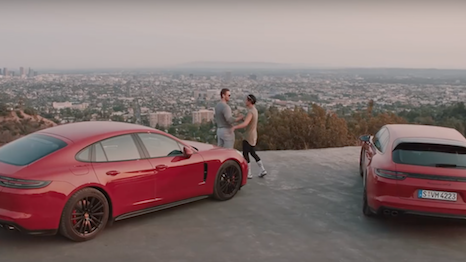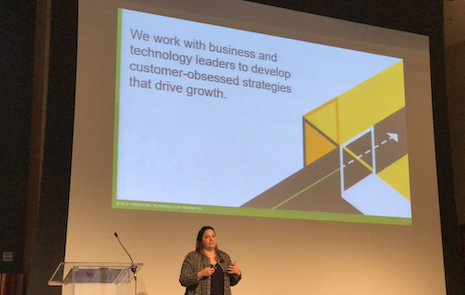NEW YORK – Marketers need to stop compartmentalizing store shoppers and online consumers and begin treating them as one and the same.
Speaking at Luxury FirstLook 2019: Digital Acceleration on Jan. 16, an analyst from Forrester Research encouraged luxury retailers and brands to reevaluate how they engage today’s digitally-savvy consumers. Companies must also adapt to use digital information throughout their own processes to get the most out of customer data.
“Luxury consumers are far more digitally engaged, mature and savvy than mainstream consumers,” said Michelle Beeson, retail analyst at Forrester Research, London.
Luxury Daily produced Luxury FirstLook 2019: Digital Acceleration
Keeping up with consumers
The majority of consumers have become channel-agnostic, and companies need to reevaluate their business models to reflect this change.
Even before setting foot in a store, shoppers interact with brands across a range of digital touch points. Seventy-two percent of the highest-spending luxury buyers inform their decisions with social media.

Porsche is selling customers experiences. Image credit: Porsche
In an effort to catch up with more successful multi-brand online platforms, luxury brands are turning to new digital strategies and alternative ways to engage consumers.
While not everyone can afford to purchase a luxury product, some companies are instead letting consumers own access to experiences.
To get more consumers in the driver’s seat, German automaker Porsche’s U.S. importer is expanding its subscription program pilot to give drivers more on-demand, short-term access to sports cars. Two new pilot programs give Porsche enthusiasts the opportunity to rent a vehicle for a period as short as a few hours — provided they live near one of the markets where the pilots are available (see story).
As luxury experiences evolve, brands are also turning to partnerships to keep pace with companies and consumers alike.

Michelle Beeson of Forrester presenting at Luxury FirstLook 2019
British fashion label Burberry is expanding its ecommerce distribution through a partnership with Farfetch.
The new alliance will see Burberry technology integrated into Farfetch’s API, allowing the brand’s entire global inventory to be retailed via the marketplace. As ecommerce growth continues to outpace overall luxury sales, this collaboration increases Burberry’s online distribution to 150 countries (see story).
Rethinking strategies
As consumers become less channel-centric, companies should also update their metric and evaluation tools to become more consumer-centric.
The Wall Street Journal’s newly launched WSJ Brand Council will be working with leading chief marketing officers to develop and test new ad concepts.
The program is designed to address challenges such as connecting with high-influence audiences in an online and mobile environment, advertising that does not dilute user experience and ensuring transparency in measurement with digital advertising (see story).
Digital and consumer data also needs to be shared with store associates to better empower them to provide personalized, contextual experiences.
Physical retailers differentiate themselves from online counterparts through lower price points, a wider assortment of goods and unique experiences. But as ecommerce is priced to match and product selections expand, bricks-and-mortar sellers are defined only by experience.
Engaging with customers on the shop floor is one of the best ways of improving that experience, and mobile technology can help sales associates accomplish that goal more effectively. However, a report from NewStore found that only 51 percent of brands empower their associates with smartphones or other mobile devices to help customers (see story).
“Start with your most valuable customers and your loyal ones,” Ms. Beeson said.
{"ct":"Ifho19dZannacZOTn1\/KtaJgdgQnMbdIspUpsPeAKuWnHcFTZsQK1x65KKNpOFF3m9455IvqvoYxfJ2HaObu4zs6BaqRYz6ZBVJ1ML562kBnPEDNmyRY7cgq4UBm5tM8DxiGK1HGPs3RDN9zQqEUcPapxNCXX80it6HpU6StIxhlCXsNe5s+GPPjOG8Ve4VjlpPBc7ds\/ZwY5pBYHLm4L6yGOshRVUUtU1xsG+pMQzDOM4joqFY\/Ilva+vXqHCx+hvk7B6qFC9BTTHIqm1Y7C9TFsIpOC\/yNA9y2ZHQHGwhVmnk68BGkcoeX\/hwL619OpusDkc04CDjr6JgJxtx28+KpP5AMcZwykMOicxqp6+dopaGoAaVSkncuU19sDi\/qQjw3YnRiCvmEE1o5TJnK1CDx8vhtiZ71lvVM6z6XyzLbiM+5gXt61VRVjwet0gAtpoczjfBFTSUCfWxtgm+Mhbxf\/jxEg\/m8F\/gubsBVnRmFtcR6UPMxnyeyf5JTvo1t0nV02ZxgsWKT2LaCf++koDCXyaHzgCCu3f2Xwn6BwbpcJKWU7FbjvUsP+y\/1rMQ3bx9NPnDDffDWetS6zoWiSw5LsEnNhmExwjPhYkFtskBDIXVxA3mDLgk+TfSElF8623WLZWYcD73h1ehhRr2jNmviFvq00IUKxL37Db9uJDKmCDuO6vKOyZo3GjGq0SOGtv1FPzCEhpzKp5R2PPBupD87YBDZSWGsw53H4Tt\/g3hXuxOndVO3U88FKAHfZKcnJ5ruwDB\/XpZ8Hw+desEP9sm1X\/5L+DW7ro\/IRdfeJxmUB5hNBOZG5eSwQUyJ2m9OjfM6h4muDJLTG3+wRvPlWUb3sqEBmEg\/yMjcV9YbMkkeLy6jF8wcljajliFPsityPfBByevGs\/P3OwDMxueuzaU382yl07Gotu1LYzCwicRXkXz9WQkJzfuKJpTR4i0vHiA7Yte8x29R9pIhUW3nZy8Om6FsUjBItbflJ667OYZvmvB6R0S\/IebqUnI5OVWLVlHCajBgRm1FrhtUbHgn\/\/5wYx3lx1Teik5gHz40528rJAt6J86++\/ikEjl4dbtSNDtyJ0guW+jOSXjVmKl3Sb1yzRmqxsPpXqB4DmflJeyVpDt1pKRgqzoYYLst7+dPjgyzkQmkkodLiHKCpTtO9FxClpzIP9RPUd7liDHEqjyBL0qcY9WLk4JvC6L\/hj+LWDDTiqlf7bsJ4QSIZhInilQm1fZ0uz8xItF6g7FVIRoJVGjNfkxo4TzBj6AZdpwsv3hYJmkkAC2tM+MBE2c7BzSlsUK4MWOuDubgQ8ZBT6oTiVkqK\/5r1q7O95NiKqI7taM4P7ZbDYGyeKwgjSOhU0EcXLAJogLCFKPmeUN5rXf+UGLAkXkrtUXybVMj4O0WaUc\/s\/XrRCF4GCfip\/w0pA\/pkir1Y6mab443AeyUBo31FY8QYY6GiSVNDZGryKT1+ETXV+N+k5yK5f0R2oXnAW7GeSuNZ5DfEnSA6Y0Gpfa179cRgP9tX7mAfeBxaV33lFWkA8IbwPFz1zu2UxpNSHE1CBUGusIXynoGsduOXX4LfEGi1S\/KSTAGEydu+gEnqOnYDBUMbbK45qNbxiYy1jbhYmUbLgpoAEhl\/ggXeYDo5\/KRQS\/BuctlSQUXjyj2v9xMz7McOIVY3ph+JinXSz3BV6WoI7W463llgZ7oYqI6gkn07rnQktODLVqsAvqHhsP6VDtoWATbS5lWMtmiJy3FcXH1hJSEmSqpnNQUBbO+xS9ityh70+6DXCdraxIaBgO9frPA3d48O94dDA+UzJ9\/pmecuW+x8byVCvO6JvnR2q03wsu3+kHcJO+pSfdizCIESlnMjd2QowdI1bxyMLwQW4fnVnuTD4TtFor4Uk+5r1is8nv9btsIZI59YPsyWcwO4ysyh\/XMf\/UnSY1pobhvQwnzTIryH5Sq+8\/LalPlQ5MP91ZrXwMU+ZQ8yCelygveqv6rjaBqnkeezb2mkFyYkd9DHpWHU1LKZ9\/4+4530fQDEUxX8ewyhIpUDBg+aXpPzKI5pvmVxYN0ZAbwzU0RR4sIaVsThr6UMNXhMlDcdgRoCxsDSOGD3XegsghB8DrGoLZfyiNYwT1uoUfml\/A523CLO\/GqtZB3yUV2rZdqu7s3sIaLnPAh3kHDrP+DqASbdjV9joOd4QfeaNvyVsG6iBSUWiO4WbX8lfz5A5gUZi6dexerBAngD0ZIAfYIRli5AjBH0oiEN++5fjnYaZe33icoclUhaLqa1CzpBysgRwLcHl05lck69igfj75IxkfiyJkghaKiMvK+iQVwLy3mwvguYsQhtuDJ9\/FBPMFg3p7yIb+Yx6m17mVBQsLqUKGki8C5FkN5ayVuJ7z5P\/klX3RAJUt9Sscsc\/OWAFeNZBNc5Ea7aU2Y2A7ClDgTaA3ZRfkfp\/MWeRnZuVLVDB+HZIWRCGRDA3+dQvmnk1IA8U6Zf1vNrQS16cu+DtOnlk6xb5sx0\/TXVStxLXkoC+5ZT3WtTJATNGr\/0g1WCtZ2wiBLrW9AWCNIyyGZwt6WxYizw4tavG+5ETWoKR\/XFvzQZ45CJA8KB5\/ClfDIcnR\/6lexm\/\/HFtrtWAOJxm8683gQLN0rAx1U81ECEHE2FqF5S+O8B86\/jjSpY28AQFVN8OVnm6SdHLmGUqEdRcNTvDZfd6\/3gWnstroVQ5Hetqc050Hvs2akPQkoJdKUGRE0k9PA8AtYYvFR+Re9T6EFW5CI71i+9JTuRORok7pPljB5MILXSGFnN2t0mQjUbOc+5IB6hcjE+ZswnPby0c9YZtnBiAUzxPh65y6GWkcB63t8dV68dPUTc2N+Pg0gtThkSP8+Pwdw7W9NgCSYIQDpf1fqNnAXKcn0wB7B32slmZBBSlp1x+4HWs\/g3lF4VIrui5rL8uH\/Tzh5vKVcsM8bk8EKs0\/FGsvDqVmrloEVs1Tccem\/NWZBreasssS8jEGejyUGywj7asZOX\/WHayicduS8aKhDBPfxqwGR8\/LT1ljLvhpGXClHxxOW0ATPtjmNXS42vW0urLaTv\/FSbs5ChXCAMTThJctGRpDdnA\/lBfj+PPLYvLkM9FDo+6Fek9rdvwZUtpIjd19GiZHo8VMZLL5KMS71nr1j+rtJChwQ8\/5rQbzJ2SiSyzS2WzS9yqjJoTGv2\/sDJz+IKZZMPY5Ow5XHF08\/IsLrEKfxJf6TjbcppWktf8LJI4YO+ic6RrJG861ZaVxWqXhHZazPutEyOgwpaJJPC3Lg4bwjHDBVSn24poE7BuOHwCS18jJC0lJ0x7DFt9hiZmPKnWGtQRhojLhRm6hV2WFyJZU4vGbRwT3\/1pAGpXsU7BGt5Jt8Te\/nSkmF7Id6fZM7AglVirrWcK6bpKaocQLlk5pLCOWA9q\/NtpvSk2lwlgBlRLkAB\/vHpuTXbw\/q16A\/qkiS20KVOwgeWTfFU\/V3d7fmKjBJJH6Bwb0OxcWyj26qwilORJfyQNdFiFmOYFPzgZ7PgR1o\/+54lbvGe\/Rg8Xuu358DZjr4+GZWpZENLlGEtEH+feYZNtmMHtPvkQ4KyKmEefn8p\/IkKXk8jjnzDeTvTO6JUxYndvbn9zDxnX+tJDnGJtDiYPCuqe+2qMT4iFECqOw6EjnjlgLdNylYrGaSU+Rtua1M+amsoCbTgfMcpBUJsIVWYh3g3mmj4xQV2luilyETBM4Wql7b9dTwwXuf6zv2EK\/fux7qjM7kZahb8Cy5YLDJ3x60oL7kKo4bymw8EyrLW6kHmhfLpYwkP97v5d0DkfhDXjlC0UHhrgec1sENotEhyOpshz6yh87y8q06fSeH4ylVKls+0zl\/aPqGXaCEDSzrdoZge7hPtHb0uxDrff2lwGEYUconyCSEIgL6zSFOVE74Hfu0CRm\/c8MqFsIGju78LGneqgdQ4dnGiGFvZgDHdwE8GYtABlSH6BODhhyNvJjLwQk8+dH5nnl9DOR\/rjy7OvKFQ1wQHqkggecWRJEYBADGqNrSraU\/x5fBJAy+TmER1fWWdlUgMvLw0mnupvQIKPTrbe4WG\/Ui1JHVu8A11MdH6Lm0XpQ18ACOzdiK860ftpwxzqXx7XFpwKhhXTtzq7ECvnSdnjl1lI+5uLibM2mb34Iz7mgupTZUMWcQkX8ma1vkE50xMO3yu+PYznw9Yt2uMH4CVa0ObVg91Et4NXg8rNQd\/oUZsIK0RYmnlaIR69Cswb52g\/Yd5fr7s6lCZ8nutaUEC2m+sG5ZkVNrUO+0Y7uCJilcif9iR\/Na\/hEqzF0e8Ad5nQVViFoHaD+\/VtJtnYOO961oXkLqsCqVU4cz9pVhRL5Zxa\/mR6uY1esehkV+o00PApd3gkeE2cQ6ldwaQDnv03vSp3lyiZD1wUswUyZE9gW1XwVvG35Uc8EhalC8PmZJ7DV65\/yRTriBo4PBwd3HnczhnE1tk0BJl\/KDucCPmDq7UaeAruFcKtPTU\/I1CHbNl0TEbxcd57rWAaSQCRdBnva3L6glygohOs3s2nVVGSCU5zZSwXrdh3dy9S3XUvPNBHHMwPlZ1\/KfsjiDDjcbA2WB9j0byY+OMhiYBhw7kNJsc\/kzhS5CjBuHNNmwyrOiswwB5RcwWOURzd6dP53tS9k7hNqehYLusbDd95ueqzTvx46P5ov1F9ekOBOzE0q4ImIWRNi8I9TC8pAcM35g7aeF2BorqWxsvxo+p\/PUGiB1pcKUtN13pg6wZ4ffB6HWcdZlHX6Ah7SKUpiZdhLnocdT\/3QkGf2AjLtUi8q4HXAKzZ2EPkb3EDEcLCGK+5+355KE\/Vsz0I6fit5p+Jc3gLPO2bKPxbviqg2kh9CQTNTgzr0oO+Xq\/1beMnWDNSKjmrUZAtWHba7tvMb07GdUmBbfsl3It3KuphNEm65xQKNGNZ1\/FdCclqIE2gg1fIErwwrLWsgys1Kf9xkDm\/48N5nlDlcLCHw2Ejie7B0JSleJxv8AqCJcGQSpm4JmY+M4HgfccxkV0zjiAo3tZsPamDpXs2tGcSWBHvv9SRWR3BIbDl2sp\/QvlFiGqF8uq17i0cQW43VkxIyWlV6St3SwgwSB6QojGuvOvA6FsBS3MgzhAC4IQ37rslUKerA0mwAisNRa8N1H5fLyER99OnUkEGiT6RR02CfsBdAb4wDI1T05xLpI1xAQ96C\/nioKPD+nmOXLoJj2SEZ5N5zdN9eho4a6zE4Iw8lARZr2PciRGEWMwSf9ywhLKU9hTKdHSndOBHNigpeB3yO8DMqYPXi2YfX5dDKHwdti2SlnJuzNLpG6VwiawzTCXirvNGBvqTJCwhhTFuQJVz9gKzARhfPWspApiaZIIbJ\/ejN5vlN2uHRte5ctgatGXh9OmrEChhkIq705qHsd+P52a2WzFir5XK6FYzifoRzfrIfdIGmqqGj5AvUqApXKFFAUsX+Pb60ujBS\/iE+pQw0rXElXYy5qkaA+gawpakAKtCSlY9gOwO3RtLydEGAEfi5oD7T0bgR7f7Bc\/ozT0\/4vPVhRY0fiGpy\/8mAhdH8dJh2I\/ko0niOYYIyEVqpfi2YUz7wuWm+vJ8fCMvRjn6VJqRW+V0yTcys3iSwBzLVFphqtK1Y6X\/uxyWXHwY0v1UKO3o+nJDyWVooKAUdgSRw73VwZTvr4rTY9\/eFQgl28\/pR+Rr9IKjsz+U8GgV7PZLfEArhZ57pSp1KX5FW793JvRG1jYL70gobQi6dEq+hUGacpFgaGNZA8EAngAqaa55TqylJFUOncAtBVst9qNhtogh6En+1P\/iBtnED4zp4q8CJaXvL4kUlHs8VEeNFy+IDpjqdLv9\/Ji6mBaW0yj0LGwIu5LdOs4389nW7Z76BT7NJTtCyy4sos\/6cZ+7288w5iNHS8UM1zaU7jhFH+y4EToTYqT3lYcQnw9xBYgTVfz1M9mT+PN24drKqaD4jnDxKATV1j11n6MIgt\/NBxycrLr1xnjcKkrMKgqq9zYKN4tQcaGnWpjjyImOMb21\/MX\/n9Et00K09DzcttvVEtxHiSeF8yiXBHjODPpvxHa5HvKEdJBMEy0rUMq2eFfz3s+2xqxbAHLP5qpznXH87yfJ7LrnryUoyDn5TCq\/9p4bLsqNr\/vVZ20IFyei0xfCTy8UXqg896jHamytuiI0sBLNR+Of+snxnDfb2GbiOQE1M\/7OgiospIZY5seMUVxI0Se3ElfNVGso7SGAkHIbxOQJQIZCAsniZfZ5QJzFpDExwgeFmJ0zL8pjF09TQzYZ1fOv67O6AICjPl5JDmhb1khxuDYT0pGbgIAomX1Z0XJpS6w6mn2BbDk3jjPSTDe4hbEaLWe913tus4wVCQKzEIjKpuIaMvw6W+bni4EzQh4E8TRBOHXS8KRxT8S9ybS4JEPZW5VUkmiBrlOId2Vtsi069pQlsSAAKni8O4\/C\/5CpOJ4lL5OXRlUfyoZWk\/J6pNHiVf\/jKlkIxheMmlxN3e4hJv2SFGzazDdGSEbkrcK7Cdzd+7kXh4ndM1BXC5UGBvzz7jkZTqUnZIgPVftD5f3tzG4IQ06x58xem0MwznITP\/d\/Te6YeuEfj6FAiYkObhGez+8tbCr+qP4+vr3msGpuLtdP7YW2Xo0Ng\/spOPykqKp5wUJBv63NM24vbiMytzHlMYlMSFQ\/Yi\/MWwKXWWdG1Wm9HwUr36K4u8DBDyScmwlCyMzx33GB4Oh0bq2NmQIO3SFxMX3w58p3HZ1RYHL\/PF0GLPkSiXr5JiAqf6p0xxpS+KOMrMjlfCxYf0yMojKqDzsMdRgAKkY1wjI\/TNq8zfMetGqTPBj1OPUhkqWuSuf7LxAQFN2KAu\/8i2rvWC6xU3eX84SKkWYgLSyvVsmVzmrZ49sVEHYY0VsAMMxnb9YoPoIRfP2f6nBgUy9lLIEwG9l7PP33f2Sxvhb1wTmvhJ7kRxP+iLeV3L5lS5IJbYj9KQbhJJAoRFP+cCNOD2qZGVEqmHW5WmRujQOqos5vfpRGlH+6TH\/0EVRIvYEdAKAiO9xesXS9Dr56bK9HnbLxQE4VtjTmevYYIpHjjV60K262vyyRAbvNP+L7I3PsmLvKiVoDLRP78TgUTnXCaFQwp4JM4v6DMOmc8V4Ji6jL5alnRhQCWvo1jgmDHBWWz++eaExT6EeSsb7iDI7Wy7D0+ryz6da+VGqBTRjanQHffCwhNY0koPK3gg\/uwRtztaCE+sNW+XhGCVC5B3kJhFkCriV+1L\/ug+oEJRC+uuaz5F5peXz5KyadfaIdlyfl\/D0dd2ofLvaJwnFIRI3Ezj1CqvtDc86Z3LMvv\/GFrykw==","iv":"c7315740b7af13a35824774d3f3d17b2","s":"8a7e7f381148f073"}

 Burberry is expanding its ecommerce reach. Image courtesy of Burberry
Burberry is expanding its ecommerce reach. Image courtesy of Burberry